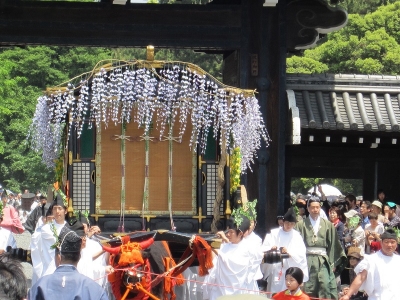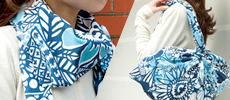History of Furoshiki
Long time ago, furoshiki was used for the cover of dancer's dress.

The term "furoshiki" began to be commonly used to refer to cloths for wrapping items around the 18th century during the Edo period. Prior to that, they were referred to by names such as "kesazutsumi," "koromozutsumi," and "ōzutsumi," depending on the contents. Among these, "hirazutsumi" (flat wrapping) appears to have been in use longer than "furoshiki."
In earlier times, cloths were used for storage purposes, such as wrapping costumes for traditional court dances, and were called "hirazutsumi" or "koromozutsumi." These were made by sewing together green twill fabrics and were not accessible to the general public.
During the Nara period, at Hokke-ji Temple in Nara, there was a steam bath where herbs were burned beneath a slatted floor to produce smoke for rituals and disease prevention. Since sitting directly on the slats was hot, straw mats were laid down, which also absorbed sweat. This practice is one theory for the origin of the term "furoshiki."
In the Heian period, artworks depict women carrying large bundles on their heads.
As the samurai class rose to prominence, it became customary to wrap the heads of defeated enemies in cloth—a practice known as "kubizutsumi"—as a sign of respect.
In the Muromachi period, when shogun Ashikaga Yoshimitsu built a large bathhouse, court nobles would wrap their clothing in cloths bearing their family crests to avoid mix-ups, and lay them on the bathhouse floor.

During the Edo period, public bathhouses became widespread among commoners. People used furoshiki to wrap their clothes and as a mat for changing. This is when the term "furoshiki" became widely recognized. Additionally, as outings like cherry blossom viewing became popular, the use of furoshiki increased.
The spread of furoshiki was also influenced by technological advancements. Until the end of the Sengoku period, cotton was a valuable imported commodity. In the Edo period, domestic cultivation and processing of cotton began, making it a common material for everyday clothing, replacing hemp.
In fire-prone Edo, furoshiki were placed under futons as a precaution. In case of fire, people could quickly bundle their bedding and cooking utensils and evacuate. This practical use led to the term "hayaburoshiki" (quick furoshiki).
After the Edo period, as commerce developed, traveling merchants like those from Toyama widely used furoshiki. Stories abound of merchants from the Kansai region gaining fame in Edo by using furoshiki emblazoned with their trademarks.
In the Meiji period and beyond, furoshiki became essential for celebratory occasions like betrothal ceremonies. They were also used to carry goods in business and to wrap textbooks and tools for school, becoming indispensable in daily life.
Manufacturing evolved from handlooms to power looms, narrow to wide fabrics, home production to industrial production, and from natural to chemical dyes, incorporating Western technologies for mass production.
From the Taisho to early Showa periods, domestic production of chemical dyes began, along with the manufacture of rayon and the introduction of screen and roller printing techniques. Some furoshiki shops established during this era are still in operation today.
Post-World War Two, new dyeing techniques were developed, and synthetic fibers beyond silk and cotton were used, leading to a variety of furoshiki being produced. Many furoshiki businesses were founded between the end of the war and the 1950s, including Maruwa Shōgyō. Around 1965, nylon furoshiki, especially those with gradient dyes, became popular for wrapping gifts and were mass-produced. They were also used as commemorative items by companies and organizations, with production peaking around 1970.

In recent years, the furoshiki has been reevaluated as an eco-friendly item. A former Minister of the Environment has taken up furoshiki with the keyword “mottainai” (what a waste). In addition, the younger generation is increasingly rediscovering Japanese culture, and the furoshiki is once again in the limelight. This renewed attention is not limited to Japan; it is also gaining recognition as Japanese culture overseas.
In the 2011 earthquake of the Pacific coast of Tohoku, they were provided furohshiki and used for wrapping their belongings.
